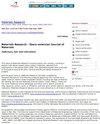巴西莓渣作为生态填料增强天然橡胶生物复合材料
IF 1.3
4区 材料科学
Q4 MATERIALS SCIENCE, MULTIDISCIPLINARY
Materials Research-ibero-american Journal of Materials
Pub Date : 2023-01-01
DOI:10.1590/1980-5373-mr-2022-0505
引用次数: 0
摘要
植物资源的生物多样性是一种可再生资源,可以作为可持续的组成部分用于各种应用。利用蔬菜废物作为聚合物复合材料的填料元素是固体废物管理政策和农业综合企业可持续发展的一部分。在这项工作中,以巴西莓籽为原料,按0、10、20、30、40和50份(每百份橡胶)的比例制备天然橡胶复合材料。复合材料在开缸混合器中均质,并通过流变学、形态学、力学和热测试表征。有机填料的加入显著缩短了硫化时间。热重分析和红外光谱分析表明,复合材料在硫化过程中热稳定,无结构变化。Lorenz-Parks方法对基质/填料相互作用的评价表明,NR/Acai之间存在较强的相互作用。新型生物复合材料可以经济、可持续地替代非生态复合材料本文章由计算机程序翻译,如有差异,请以英文原文为准。
Acai Residue as an Ecologic Filler to Reinforcement of Natural Rubber Biocomposites
The biodiversity of plant resources is a renewable source that can use as a sustainable component in various applications. The use of vegetable waste as a filler element in polymeric composites is part of the solid waste management policy and the sustainable development of agribusiness. In this work, the natural rubber composites were prepared with acai seed in proportions of 0, 10, 20, 30, 40, and 50 phr (per hundred rubber). The composites were homogenized in an open cylinder mixer and characterized by rheometric, morphological, mechanical, and thermal tests. The addition of the organic fillers significantly reduced the vulcanization process time. Thermogravimetric analysis and infrared spectroscopy showed that the composites were thermally stable and showed no structure changes after the vulcanization process, respectively. The Lorenz-Parks method’s evaluation of matrix/filler interactions showed a strong interaction between NR/Acai. The new biocomposite can replace non-ecological composites economically and sustainably
求助全文
通过发布文献求助,成功后即可免费获取论文全文。
去求助
来源期刊

Materials Research-ibero-american Journal of Materials
MATERIALS SCIENCE, MULTIDISCIPLINARY-
CiteScore
2.40
自引率
11.80%
发文量
161
审稿时长
3 months
期刊介绍:
Information not localized
 求助内容:
求助内容: 应助结果提醒方式:
应助结果提醒方式:


